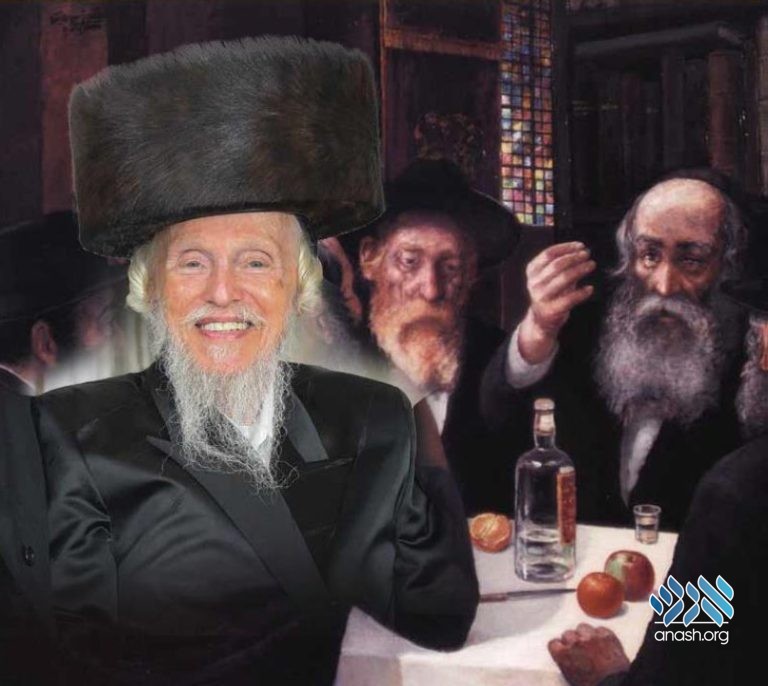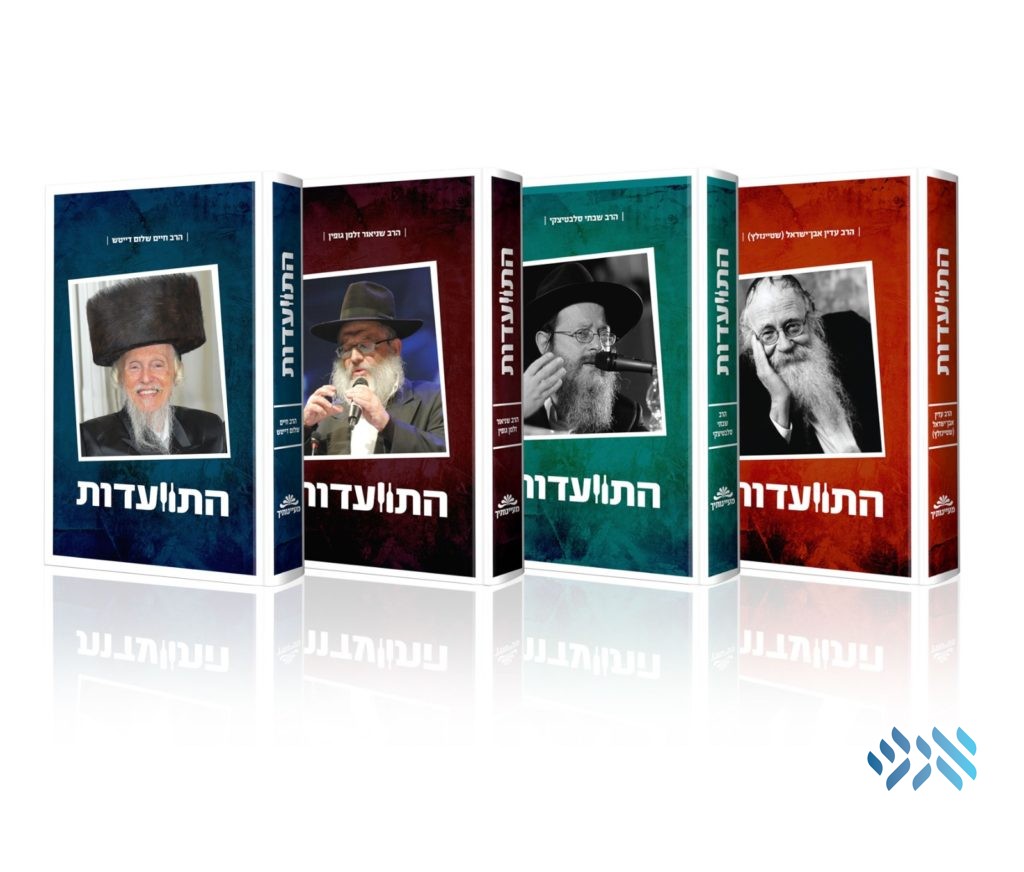As the book of farbrengens by Harav Chaim Sholom Deitsch is set to appear on shelves soon, writer Binyamin Lipkin visited Reb Chaim Sholom for a talk about farbrengens.
By Binyamin Lipkin
Translated by Asharon Baltazar for Anash.org
As the book Farbrengen by Harav Chaim Sholom Deitsch is set to appear on shelves soon, I visited Reb Chaim Sholom’s home for a talk about farbrengens, its effect, and the parts that make up a good farbrengen.
“The truth of the matter,” Reb Chaim Sholom sighs, “is that the farbrengens today are incomparable to those before. Why should someone crowd around someone else and listen to him talk about his opinions and feelings? There’s plenty of Chassidus to glean from, where everything is already explained and talked about – just open the sefer and look inside. The farbrengens I’m talking about are something entirely different.
“Farbrengens were once affiliated with dignified people. Mashpi’im. Baalei avoda. Not a single vort, regardless of how catchy it might have been, would have left their mouths unless they had engraved that very concept into their souls.
“It was clear the Yid sitting and conducting the farbrengen was speaking his soul – he and the Chassidus he learned were a singular entity. Just one big shtick of Chassidus. And when these words would leave his mouth, everything was perceived differently.”

FARBRENGEN PERSONALITIES
When Reb Chaim Sholom speaks about these mashpi’im, it’s natural for him to visualize his own mashpia, someone who established his own legacy.
“The person whose farbrengens I would attend on a regular basis was the legendary mashpia Reb Shlomo Chaim Kesselman, a”h. He also taught a shiur Tanya which mesmerized the entire yeshiva. He didn’t say anything notable. He would read some Tanya and follow up with an explanation. In the course of one zman, he would finish all of Likkutei Amarim. If it was a leap year, he’d also manage to finish Shaar HaYichud VehaEmunah. And during Aseres Yemei Teshuva, he would teach Igeres HaTeshuva.
“These shiurim had a certain charm. And as I could attest about myself, just like every other bochur, I too had my ups and downs. Whenever I was dispirited, these classes inspired me. Why did this happen? Because he read the words in a manner different than any other person could. The words just sounded different.
“Reb Shlomo Chaim showed me how to start my avodas hatefila. He told me what to learn, what to think about, and then he said, as though a promise, that I’d sense a change in the words.”
Reb Chaim Sholom returns to the narrative at hand: farbrengens.
“As it is, conducting a farbrengen isn’t something everyone is able to do. Some would beg Reb Meishke (Reb Moshe Naperstak a”h, later a mashpia in Tomchei Tmimim Kfar Chabad) to farbreng, but he refused and never said a word. Today, it’s a pretty common thing to see – in mesivta and zal, every maggid shiur for Chassidus farbrengs. It’s become an inseparable part of the job.
“I myself, for quite some time, didn’t farbreng. For years, people begged me to speak, but I was adamant and always refused. I used to bring Reb Zelig Feldman to the Tzemach Tzedek Kollel, and he would try and coax me into saying something. I declined. When I finally did start to farbreng, I did it because there was no one else.
“Reb Shlomo Chaim was a master in defining concepts in both Chassidus and nigleh. This is how he defined a farbrengen:
“The order on Shabbos is that we first learn Chassidus, then we contemplate what we learned and follow with davening. Once we’re finished with those, we can sit down to farbreng. So he said, learning, that’s the mind. Contemplation, which is about internalizing the material, that’s the heart. And farbrengen, which is about implementing it all, is action.
“Back then, chassidim who farbrenged usually spoke about things they’d struggled with. I remember Reb Munke (Reb Meir Tzvi Gruzman a”h, one of the roshei yeshivos of Tomchei Tmimim Kfar Chabad) once farbrenged. After saying too many “l’chaims,” he admitted his envy of Reb Shlomo Chaim because when Reb Shlomo Chaim started to farbreng on Yud-Tes Kislev, his face would glow. It was obviously yom tov for him. ‘I know,’ said Reb Munke, ‘he wore Shabbos clothes. So what? I also tried wearing Shabbos clothes, but that didn’t help.’”
When Reb Chaim Sholom describes the farbrengen on Yud-Tes Kislev, he says:
“The schedule consisted of Reb Shlomo Chaim farbrenging at night, and on the following afternoon, the older bochurim were bussed to Rishon LeTziyon for a special farbrengen with Reb Chaim Shaul Brook. To this day, I remember a lot of what was said during those farbrengens. And when we came back, Reb Shlomo Chaim would always ask to repeat what Reb Chaim Shaul said.
“I remember telling him I was incredibly impressed with one of the stories. Reb Chaim Shaul told of how Reb Shilem, a mashpia in Lubavitch, was blessed with a son close to Yud-Tes Kislev. During Reb Shilem’s farbrengen with the bochurim, someone said ‘l’chaim’ and blessed his happy occasion. Reb Shilem, looking stunned, told him, ‘We’re currently celebrating the extraordinary simcha of Yud-Tes Kislev. How do you even compare the two?’
“I told Reb Shlomo Chaim this story quite enthusiastically. But when I finished, he tapped on my head and reprimanded me, ‘And why are you so amazed? Isn’t it obvious?’ In those moments, I realized his rebuke was sincere, and for him, it was common sense.
“Here’s a good example of the way they saw things. Reb Shlomo Chaim and Reb Chaim Shaul were both classmates. After the two got married, Reb Shlomo Chaim became a mashpia (first in Rostov, and later in Poltava and Polotzk), while Reb Chaim Shaul became a rov. They both later emigrated to Eretz Yisroel, but Reb Chaim Shaul was first, and he opened a yeshiva in Tel Aviv (among his first students was Reb Yoel Kahan).
“When Reb Shlomo Chaim later arrived, Reb Chaim Shaul relegated the yeshiva’s care over to him, as though it was completely natural, and opened another one in Rishon LeTziyon. Do you think something like this would’ve happened today? Who in their right mind would resign from their position for their friend?
“Now that we understand the paradigms we’re talking about, and the level they both spiritually lived on, we’re able to finally understand what their farbrengens were like. They exposed their listeners to the elevated standards they lived and breathed.
“It’s impossible to conduct a genuine farbrengen unprepared. Not long ago on Shabbos night, towards the end of the meal, a group of bochurim knocked on my door holding two bottles of mashke – they wanted me to farbreng. I said no. There’s no such thing to farbreng impromptu.”
CONNECTING LEARNING TO LIFE
Once I understood the true meaning of a farbrengen, I ask Reb Chaim Sholom to explain the advantage of attending a farbrengen rather than just learning from a book. His eyes light up and he explains:
“The purpose of a farbrengen is to enrich our daily lives with whatever is in the books. It’s possible to learn a lot and fail to grasp that learning is meant to illuminate: my behavior at home, my relationship with family, with friends, with students. That’s the farbrengen’s objective.”
He suddenly chuckles and proceeds to confess, “Some accuse me of speaking too much about Sholom bayis and chinuch at my farbrengens. I guess they’re right. I also think that’s the farbrengen’s entire point. If Chassidus demands you to subdue your ego, you’re supposed to translate it to your daily life and live with your spouse in peace. And if needed, you’re also supposed to be on the receiving end of the stick without answering back.
“Occasionally, I don’t wait till the farbrengens and prefer to inject real-life examples in my daily classes from ideas we recently learned. Indeed, some also accuse my Chassidus classes of being too similar to a farbrengen. I have no qualms with such comparisons. And to tell you the truth, I consider them a compliment.”
Reb Chaim Sholom tells of a social psychology professor, who upon his retirement, began attending the kollel. He would time and again express his amazement at the solutions Chassidus offers for behavioral problems.
“Not once nor twice, he’d bring his patients to Chassidus classes and farbrengens. One day, I notice a new face, and turns out, the professor sent him over to me. The man started to bring his wife over. She complained about his temper, which was vile and affected everyone around him. He was also open about it. I recommended he take up learning Chassidus seriously, but he found it too hard and his wife kept demanding a get.
“I came with him to beis din and requested the dayanim give him one more chance to change. They forbade me from coming inside, and so, the get was written and signed. After that, the two of us began learning the sefer Erech Apayim, authored by a Chassidic Yid. In the end, the man learned to calm down and control himself, and now he is BH happily remarried.
“What made him change? During one of my farbrengens, Hashem slipped this message into my words: A connection cannot exist unless both things are subservient to a Higher Power. A man and a woman are, in their nature, incompatible. For there to be some sort of connection, something has to exist above them. A Yid knows that a lifestyle according to Torah instills the Shechina in the home. The husband represents Hashem, and the wife, the Jewish people. Together, there exists a bond between Hashem and the Shechina.
“Sometimes, I said, a couple might suggest the ‘Higher Power’ connecting them is the children. But then what happens? If the relationship turns turbulent, they might rightly claim it’s detrimental for the kids. Torah is the only value that can prevail. This fresh perception, which changed the man’s life entirely, came about during a farbrengen.”
I ask Reb Chaim Sholom how he views the consumption of mashke during a farbrengen, and to explain its purpose.
“The simple answer,” he replies, “is it’s a means of clearing obstacles. I once had a gifted yungerman from the Litvish world sit with me and clarify the idea: For frum Yidden, implementing Torah into action is a matter of kabala. Now, there exists a gap between the emotions and the action, and therefore, it’s dry. If we want to bridge that disconnection between the heart and action, we introduce mashke. Chassidishe farbrengens were composed of emotions. If there weren’t enough raw emotions, they would raise small cups of l’chaim and start singing. That’s how we connect the heart and action.
“For a good chassidishe farbrengen, there’s one more ingredient crucial to the mix – the participants. Farbrengens don’t exist without their participants, and this is the difference between farbrengens and studying or davening. Learning Torah with others is no small thing, but it’s possible to do it alone. Davening in a minyan is spiritually important, and many things are only said in a minyan, but nonetheless, one could still daven alone. The only thing in avodas Hashem that’s impossible to do is farbreng by oneself.
“You cannot farbreng alone. A farbrengen must be done specifically in a group of people who inspire one another and enhance the farbrengen simultaneously.
“It’s crucial for us to note the other unique element of the farbrengen – it’s a common denominator that unites all chassidic groups. Chabad calls it farbrengen in Yiddish, or hitvaadut in Hebrew. Others would call it ‘zitz’ or ‘boteh,’ and so on and so forth. But they’re all equivalent in the fact that chassidim sit down and farbreng with one another and inspire one another. This practice originated from the Baal Shem Tov or the Maggid of Mezritch.”
As he says this, Reb Chaim Sholom also mentions the effect participants impart during a farbrengen. “It’s happened to me more than once that solely during a farbrengen Hashem illuminated my eyes and the eyes of the participants. When people come to me asking for help with yiras Shamayim, sometimes I immediately advise them and sometimes I suggest coming to my next farbrengen and remind me of their question then. I’ve observed that farbrengens put the right words in my mouth, and besides the crowd playing a major role, I have no other explanation.”
Tears twinkle from the corners of his eyes as he recalls many who reformed their entire lives as a result of a farbrengen and its highpoints.
He shares a chilling story of an individual who recessed further and further into sin. In the midst of a farbrengen, somewhere around two in the morning, the individual aspired to shed his previous life, ascend beyond the dark shell shrouding his soul, and embrace the light.
“In truth,” continues Reb Chaim Sholom, “I don’t need examples to make my point. I myself came to Tomchei Tmimim because of a farbrengen.”
As our conversation wraps up, we return to his beloved mashpia Reb Shlomo Chaim.
“I used to come to Reb Shlomo Chaim’s farbrengens even as a bochur of the Ponovez mesivta. For that, I needed permission, which I always received, provided I didn’t miss one minute of seder. Hashem helped me and made sure that never happened. This continued even throughout Ponevez zal. Reb Shlomo Chaim would notice me, but he never paid any special attention to me.
“The final change came about during a farbrengen of Yud-Tes Kislev. I was 19 years old. Reb Shlomo Chaim simply wouldn’t leave me alone and kept refilling my cup with mashke. I will never forget the words he used borrowed from the Mishna: ‘The animal is watered before slaughter.’ Water helps with skinning the animal. Mashke removes the nefesh habehamis and allows the nefesh Elokis to affect the person. After this farbrengen, I realized where I truly belong.”
“It’s quite evident,” summarizes Reb Chaim Sholom, “the farbrengen is simply a unique expression of the soul that is unobserved anywhere else, neither in davening nor in learning. It’s the special atmosphere of the farbrengen which rouses the soul. The niggunim sung throughout aren’t just fillers between segments. Rather, they’re the ropes used to pull the soul up.”
L’chaim, l’chaim velivracha!

